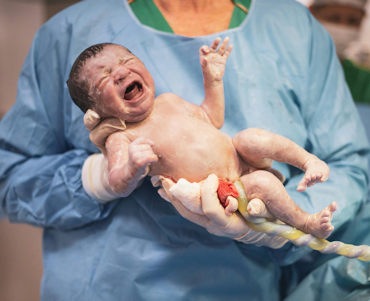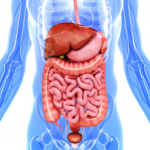
Dr. Maxwell Nartey
Professor of Symptometric Science, American School of Symptometry, NFP
World Center for Cell Education and Scientific Enlightenment
I decided to write this article to enlighten women still in the dark. They have been led to believe that caesarian section delivery is safe and fast. Yes, the baby will be delivered faster, but at what cost? Let me ask a few questions to kick off this discussion.
Why is the woman in labor for 18, 20, 28 hours in the first place? She is in labor for all this time for three reasons: 1) she lacks enough oxytocin to dilate her cervix maximally, 2) her motor neurons lack electrical energy, power, strength, and pressure to “push” the baby out of her womb and 3) her baby’s motor neurons are not as strong as they should be, causing her mother to be overcome by labor inertia.
After 28 hours of inertia, the obstetrician would decide to act because he or she has waited too long. Their action is a C-section. The C-section will be performed, and the baby will be delivered. Then, what? It would be a new beginning for the mother and her child.
The baby’s new beginning will be growing up with neuronal disorders, one of which is constipation. Others are:
- Anxiety
- Extreme nervousness
- Panic attacks, sometimes bordering on hysteria
- Fear
- Risk for respiratory distress
- Lack of courage
- Obstinacy
- Baseless and unjustified suspicions
Statistics from the US Department of Health and Human Services show that 23 out of every 100 babies were delivered through C-section in 2022. This is a lot of babies. This means about one-quarter of 100 children will become adults with emotional problems.
Emotional problems turn into bad habits and behavioral problems. Then, behavioral problems turn into marital problems and problems in relationships.
If the man is not causing the problem in the relationship, the woman is.
Turbulence in relationships is not new. What is new is that Symptometry is associating such turbulence with C-sections in modern times.
Just imagine how complicated the emotional problems of a person born through a C-section would be after their parents have separated or divorced. It would be beyond description.
Every country is affected by the turmoil caused by C-sections, and obstetricians will not stop performing C-sections because it is a lucrative business that puts more money into their pockets. Therefore, it is up to the pregnant woman to do everything she can to deliver her baby vaginally, and Symptometry is here to provide this service.
What about the woman? Her new beginning will entail experiencing one or several of the following disorders for the rest of her life:
- Infections. Why are women who underwent a C-section prone to infections? Food for thought.
- Incontinence due to a weak bladder. Urine leaks when coughing, laughing, or sneezing or the woman has to rush to the bathroom because she cannot hold urine for 1 minute. How many women wear incontinence pads? Millions, and most of this is because of C-sections.
- Chronic cystitis (bladder inflammation) or UTI.
- Damage to the plexus in the woman’s bladder or uterus.
- Possibility of stillbirth.
- Placenta previa.
- Uterine rupture.
- Itching caused by anesthetic drugs.
- Feeling sore all over. Some say it is normal. Symptometry disagrees.
- Experiencing unbearable postpartum pain due to anesthesia and surgery. Some say it is normal. Here again, Symptometry disagrees.
- Varicose veins.
- Constipation.
- Hemorrhoids.
- Vasculitis.
- Blockages. Scar tissue adhesions tend to cause blockages in the bladder. Adhesions can also cause future pregnancy complications such as placenta previa or placenta abruptions
- Loss of libido. Many women have remained frigid indefinitely, causing marital problems that are hard to disclose, even in court papers.
Placenta previa
In placenta previa, the placenta is too low in the uterus, covering the cervix. As a result, the blood vessels connecting to the placenta tend to rupture, causing flooding.
Flooding refers to severe and uncontrollable bleeding that goes on for 45 minutes to an hour, making the woman extremely anemic and weak. Some women die from blood and oxygen loss. According to statistics, 4 – 8% of women die every year due to placenta previa complications.
Also, the surgical removal of fibroids before conception can cause placenta previa. Therefore, for women who have fibroids surgically removed before they become pregnant, beware.
Placenta abruption
In placenta abruption, the placenta separates from the uterine wall, causing the placenta and baby to float. Between 20 and 47% of babies die in the womb as a result of placenta abruptions.
Placenta accreta
In placenta accreta, the placenta grows too deeply into the uterine wall, causing part of the placenta to remain attached to the uterine wall after delivery in a situation called retained placenta. The baby is out, but the mother is not yet out of the woods.
Considering the above complications associated with parturition (birthing), Dr. Dana Raphael believed that doulas would help alleviate the trauma of birthing. Was she right? Let’s find out—first, the doulas.
Doulas
Doulas play a significant role in the lives of pregnant women who lack moral, physical, and mental support. Their support is critical in minimizing trauma associated with childbirth because such trauma often drives many women to insanity.
Another reason that justifies doula service is fear and nervousness. First-time mothers have heard many horror stories about dying during or after childbirth. For this reason, they do not want to die. As they are overcome by heart-wrenching nervousness and fear and obstetricians do not have the faintest idea about what they are going through, the doula becomes the most reassuring provider of support in the woman’s life in the delivery room.
The doula’s presence restores confidence, and holding the first-time mother’s hand calms her down, dissipates tension and friction, fills her with the determination to succeed, and strengthens her motor neurons even more, allowing delivery to proceed smoothly.
Childbirth is not just a mechanical process involving a scalpel, Allis tissue forceps, curved Mayo scissors, Foerster sponge-holding forceps, etc. It is a human thing.
As an energy-dependent biological existence, vibrations, waves, frequencies, and energy transfer are involved in delivering a baby. The woman is about to undergo a major transformational experience that will either scar or traumatize her for life or make her a happy producer of the intersection of the visible and invisible, a human being.
Indeed, this is a momentous occasion worth remembering for the rest of her life. Nothing is more gratifying than a doula participating in this momentous occasion.
The doula’s energy in the delivery room is strong enough to facilitate cell self-correction in the woman. Cell self-correction can reverse placental disorders, allowing delivery to proceed smoothly in many cases.
The woman needs a person she can trust in this moment of emotional and mental crisis, and the doula is that person. As a result, the bond that forms between the new mother and the doula is rock-solid and will last a lifetime.
Midwives and obstetricians are allopathic professionals bent on enforcing the rules of procedure. The doula does not stand in their way. She is in the delivery room to prevent an emotional crisis and a nervous breakdown, making the doula the bridge between mechanics and human feelings.
History of doula service
A doula is a non-medical caregiver who provides emotional, massaging, and mental support during labor and after childbirth. As Dr. Dana Raphael put it, this objective is achieved by “Mothering the Mother.”
Dr. Dana Louise Raphael (January 5, 1926 – February 2, 2016), medical anthropologist, coined “Doula” in 1969 in her anthropological writing and is credited with launching the doula moment in the United States. She was a strong advocate of breastfeeding. Why? She could not breastfeed her baby. She established doula workshops and retreats to promote doula service throughout the United States and Canada.
In 1986, researchers Marshall Klaus, John Kennell, Steven Robertson, and Roberto Sosa published an article in the British Medical Journal titled “Effects of social support during parturition on maternal and infant morbidity.” To them, post-traumatic stress and ailments associated with childbirth amounted to morbidity.
After observing and studying 465 women in Guatemala, their article confirmed that women who benefitted from doulas fared better than women who did not. Even though doulas helped reduce labor from 18 to 8 hours, Symptometry reduces labor time even more to one hour or less.
Doula service and Symptometry
Doulas transfer positive energy to the woman soon to become a mother. They will be of even greater service if the soon-to-be-mother is in the Symptometry pregnancy management program. Why? Because the particulates that Symptometry recommends for cell self-correction are loaded with positive vibrations, force, frequency, power, pressure, and strength for cell self-correction and self-perpetuation.
Familiarizing themselves with Symptometry’s teachings allows doulas to monitor their clients’ meals more closely, causing them to eliminate foods and beverages that negatively impact motor neurons, the production and release of oxytocin, and the production of neurotransmitters.
No one needs oxytocin, strong motor neurons, and neurotransmitters more than a soon-to-be-mother. The researchers agreed that doulas make the new mother’s life a little bit more comfortable by mitigating stress and fear. Still, Symptometry goes beyond stress and fear to work on neurotransmitters, the neuropeptide called oxytocin, and the baby’s and mother’s motor neurons to prevent placental disorders and labor inertia.
The plight of women
Many things can go wrong with C-sections, and obstetricians admit that, but women are not told the truth about all there is to know about C-sections. This could be why many women have only one child, and that’s it. No more. Here is my question.
If women in industrial nations continue to have only one or two children, how can they build a workforce to sustain an ever-expanding economy? Will they import workers from developing countries and liberalize immigration to solve this worker shortage crisis? Let me take a moment to discuss the history of C-sections.
History of C-sections
The first C-section was performed in the 1580s in Switzerland by a veterinarian known for castrating pigs. His wife’s labor was not progressing, and she was in so much pain that out of an abundance of love for his wife, he took one of the sharp objects for castration, cut open his wife’s abdomen, and took out the baby. According to records, his name was Jakob Nufer of Siegershausen, Switzerland.
Amazingly, his wife survived the operation and went on to have five more successful vaginal births, including twins. After reading this story, my questions were: 1) if infections are common in a hospital setting, how did Jakob Nufer prevent infection and inflammation on a pig farm? 2) how did he stop profuse bleeding? and 3) how did he control her pain?
Medical scientists perfected Jakob Nufer’s craft of cutting the pregnant woman’s abdomen and added anesthesiology, stitching, and antibiotics. Then, obstetricians and midwives were trained to create a new branch of allopathic medicine called obstetrics.
A Latin scholar came across the word “caedare,” meaning “to cut;” an adjective was made of it, and it has since become a medical procedure called Caesarian operation.
Some speculate that the procedure was named after the Roman Emperor Julius Caesar, but the circumstances regarding the Emperor and the procedure remain unclear. No records of cutting a woman’s abdomen to remove a baby between 46 and 44 BC when Julius Caesar was Emperor of Rome were ever found. Therefore, the credit should be returned to Jakob Nufer, the Swiss veterinarian who invented the C-section to end his wife’s pain and suffering.
The original C-section, aka the Jakob Nufer method, was meant to end the woman’s pain and suffering, but this time, it is done with anesthesia in a hospital, not on a pig farm.
The Symptometry solution
Symptometry’s solution is to considerably minimize the woman’s pain and suffering associated with labor. If labor progresses fast, the baby or babies will be out in no time, allowing nurses to tidy up the ward quickly.
Also, if a woman, early in her pregnancy, is ready to 1) stop eating foods that poison or damage her motor neurons, 2) start eating and living scientifically, and 3) take particulates and molecules to produce oxytocin and strengthen her motor neurons, she will successfully use Symptometry’s pregnancy management service to deliver her baby or babies vaginally.
In truth, she will love every effort she puts into delivering her babies vaginally with little postpartum discomfort and stress.
C-sections are barbaric and downright cruel to the mother and the baby. They are too traumatic, to say the least.
Advantages of vaginal birth
Vaginal birth, under Symptometry’s guidance, is preferable to C-sections for the following reasons:
- After maximal cervical dilation, the baby is delivered in less than an hour. Many delivered their babies in 10 minutes or less. Women who previously delivered their baby by C-section must bring their previous experience to Symptometry’s attention so adhesions are thoroughly ionized to prevent placenta accreta.
- Vaginal tear is minimal, and particulates that deliver electrical power, strength, and force will be provided to facilitate fast vaginal granulation.
- The baby boy or girl is born strong and healthy without trauma.
- The mother remains strong and energetic after delivery, has minimal soreness, and is ready to breastfeed her baby for up to a year.
- The woman experiences no trauma whatsoever.
- The Apgar test score is high, 9 or 10; the baby or babies pass the newborn screening tests with flying colors.
- The woman’s libido will be back after vaginal granulation, as the connection with her adrenal gland is restored.
Women have been led to believe that delivering a baby is not a risky endeavor. It is, especially when things do not go as planned. Hence, it is always important to benefit from Symptometry’s service throughout gestation and after delivery.
References
- Sewell, Jane Eliot (1993), Cesarean Section: A Brief History (PDF), National Library on Medicine], archived from the original (PDF) on 2004-11-05
- Connell, Lisa. “Westport Center Studies Breastfeeding Around the World.” New York Times (1978). http://www.nytimes.com/1978/02/26/archives/connecticut-weekly-westport-center-studies-breastfeeding-around-the.html?url=http%3A%2F%2Ftimesmachine.nytimes.com%2Ftimesmachine%2F1978%2F02%2F26%2F110938928.html%3FpageNumber%3D88.
- Dana Louise Raphael.” The Friends Journal (2016). https://www.friendsjournal.org/dana-louise-raphael/.
- Jones, Maggie. “Dana Raphael: Investigating why American women did – and did not – breastfeed.” New York Times (2016). https://www.nytimes.com/interactive/2016/12/21/magazine/the-lives-they-lived-dana-raphael.html.
- Kishi, Rieko. “Breastfeeding and doula support interview with Dana Raphael.” University of Illinois at Chicago College of Nursing. (2007).
- Mead, Margaret, Anna Sieben, and Jürgen Straub. Coming of Age in Samoa. Harmondsworth: Penguin Books, 1943.
- Mead, Margaret. Sex and Temperament in Three Primitive Societies. New York City: Morrow, 1963.
- Moorhead, Joanna. “Milking it.” The Guardian (2007). https://www.theguardian.com/business/2007/may/15/medicineandhealth.lifeandhealth.
- Raphael, Dana, ed. Being Female: Reproduction, Power, and Change. Chicago: Walter de Gruyter, 1975.
- Raphael, Dana, ed. Breastfeeding and Food Policy in a Hungry World. New York City: Elsevier, 2012.
- Raphael, Dana. “Commentary: Weaning is Always: The Anthropology of Breastfeeding Behavior.” Ecology of Food and Nutrition (1984): 203–13.
- Raphael, Dana. “Support and Variation, the Needs of the Breast-Feeding Woman.” Pediatrics International 31 (1989): 369–72.
- Raphael, Dana. “The Tender Gift: Breastfeeding.” Columbia University. (1973).
- Roberts, Sam. “Dana Raphael, Proponent of Breast-Feeding and Use of Doulas, Dies at 90.” New York Times (2016). https://www.nytimes.com/2016/02/21/nyregion/dana-raphael-proponent-of-breast-feeding-and-the-use-of-doulas-dies-at-90.html.
© Copyright 2024, The American School of Symptometry, NFP. No part of this publication may be reproduced or transmitted in any form or by any means, electronic or mechanical, including photocopying, recording, or by any information storage and retrieval system without the written permission of The American School of Symptometry, NFP. Library of Congress copyright number Txu 1-621-370, Washington D.C.


 Previous Post
Previous Post Next Post
Next Post